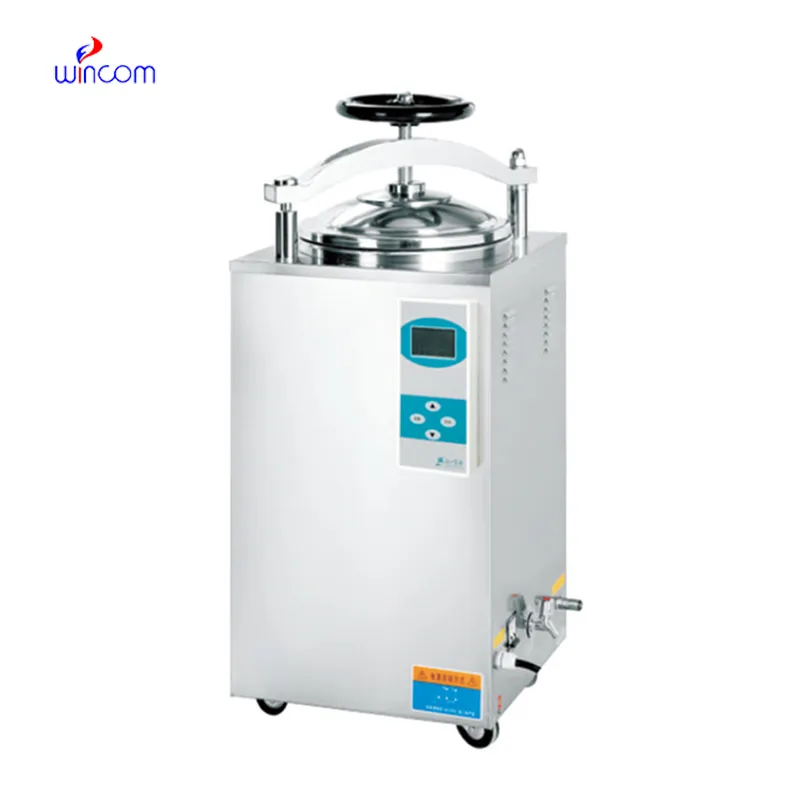
Blog
In medical, pharmaceutical, laboratory, and food processing environments, two primary sterilization methods are commonly employed: steam sterilization and dry heat sterilization. While both methods are effective in sterilizing materials, they operate on different principles and have distinct advantages and limitations.
An autoclave sterilizer is a device that uses high-pressure saturated steam to sterilize medical instruments, laboratory equipment, and other items. It is highly effective in eliminating bacteria, viruses, fungi, and spores. Steam sterilization is a widely adopted method in medical and laboratory environments. It works by using high-pressure steam to eliminate microorganisms, with the elevated pressure allowing temperatures to exceed the standard boiling point of water.
Vertical Pressure Steam Sterilizers from the SS-V Series are engineered to accommodate various sterilization requirements. Models such as the SS-V35HD, SS-V50HD, SS-V75HD, and SS-V100HD offer chamber capacities between 35L and 100L, with adjustable temperatures of 126°C or 134°C. These features make them suitable for clinics, laboratories, and light industrial applications.
The primary advantages of steam sterilization include its speed, broad-spectrum efficacy, and ability to penetrate complex or densely packed items. With typical cycles lasting between 30 and 60 minutes, steam sterilization ensures both time efficiency and a high level of microbial elimination.

Dry heat sterilization is a method that uses hot air at elevated temperatures to sterilize items. Unlike steam, there is no moisture involved, and items are subjected to high temperatures for extended periods. This method works by denaturing the proteins and enzymes of microorganisms, causing them to lose their functionality and ultimately killing them.
The application of dry heat sterilization has been demonstrated to be a particularly effective method for the sterilization of heat-stable items that are susceptible to damage from moisture, including powders, oils, and certain metal instruments. Its utilisation is prevalent in the pharmaceutical and food processing industries. The process typically requires higher temperatures (ranging from 160°C to 180°C) and longer exposure times than steam sterilization, often taking several hours to complete.
One of the key benefits of dry heat sterilization is that it eliminates the risk of rust or corrosion, which can occur with steam sterilization when moisture is present. Additionally, dry heat sterilization is ideal for items that are moisture-sensitive or can be adversely affected by steam, such as certain types of packaging or equipment that must remain dry.
When it comes to choosing between steam and dry heat sterilization, several factors must be considered. Both methods are effective, but they differ in speed, effectiveness, and suitability for different materials.
Steam sterilization is generally much faster than dry heat sterilization. The high-pressure steam can sterilize items within a short time frame, often in less than an hour. Dry heat sterilization, on the other hand, requires longer exposure times, which can be inconvenient for industries that require quick turnaround times.
Steam sterilization is more effective against a broader range of microorganisms. The combination of heat and moisture enables it to kill bacteria, viruses, and fungi quickly. Dry heat sterilization, while effective, tends to be slower and requires higher temperatures, which may not be as effective against certain types of microorganisms at the same rate as steam.
Steam sterilization can potentially damage heat-sensitive materials, particularly metals or instruments prone to corrosion if not properly maintained. In contrast, dry heat sterilization is preferable for materials that cannot tolerate moisture, such as powders, oils, and certain types of glassware, as it avoids the risk of rusting.
Both steam sterilization and dry heat sterilization are effective methods for sterilizing equipment, but they each have unique strengths that make them better suited to different applications. Dry heat sterilization, on the other hand, is preferred for materials sensitive to moisture and requires higher temperatures for effective sterilization. Steam sterilization is faster, more effective against a broader range of microorganisms, and ideal for moisture-tolerant materials. Advanced models like the Vertical Pressure Steam Sterilizer (SS-V Series) offer precision, reliability, and safety features that ensure efficient and effective sterilization.
E-mail: [email protected]
Tel: +86-731-84176622
+86-731-84136655
Address: Rm.1507,Xinsancheng Plaza. No.58, Renmin Road(E),Changsha,Hunan,China